Top attractions:
Quick Navigation
About Puchberg am Schneeberg
Some places are so rich in nature and in culture, that it might be even possible to give them some justice in words. Once upon a time, Austria used to be the heartland of a great empire, ruled by Habsburg Dynasty. Although today, it might not be obvious on every corner of the state, the remnants of the Empire is definitely noticeable in the highest point of Lower Austria – Schneeberg. Wealthy states simply don’t leave such places unnoticed.
Since 1897, Schneeberg railway connects Vienna to the minor peak of the mountain – Hochschneeberg, 1800m / 5900ft. Despite what you might think, the First Emperor ascended to the top of Lower Austria decades ago before the first trains brought people up there. In 1901, thanks to Schneeberg Railway, Emperor Franz Joseph I of Austria was able to build a Church in the memory of his late wife Empress Elisabeth, today better known as Sisi, at the elevation of 1,796m / 5,892 ft above the sea level.

The area is so magical, that I bet cows DO drink milk here and in turn produce Milka chocolate. Photo by Alis Monte [CC BY-SA 4.0], via Connecting the Dots
The Idyllic Valley
The area between SPA town Puchberg and Mount Schneeberg is an oasis of the typical idyllic landscape of the Alps, just right next to Vienna. Though it is a popular destination among local nature lovers, one could live a lifetime in the Capital of Austria without realizing about this neighboring paradise. Which is a pity. Puchberg am Schneeberg provides what every typical inhabitant of a big city lacks – peace of mind.
One could spend hours and hours just staring at the magnificent Mount Schneeberg and the surrounding landscape without getting bored. The ever-fresh mountain air seems to cleanse the body from every inflammation of everyday life routines. The meaning returns, as the far-reaching troubles helplessly decay into non-relevance. In short, hiking around Puchberg am Schneeberg should be prescribed as a therapy, and, in fact, it is. So, why hesitate?
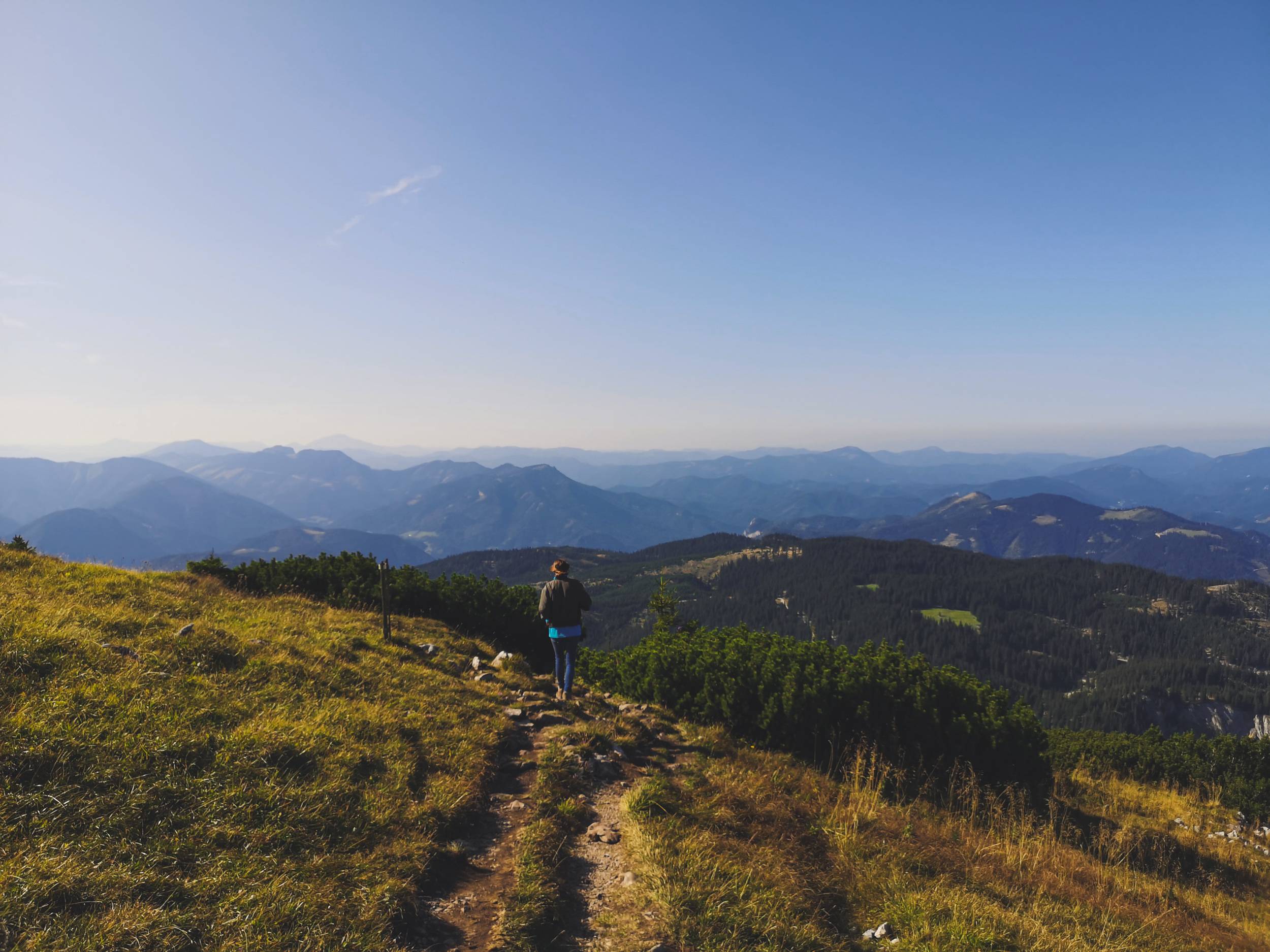
The area is so magical, that I bet cows DO drink milk here and in turn produce Milka chocolate. Photo by Alis Monte [CC BY-SA 4.0], via Connecting the Dots
Puchberg am Schneeberg Details
- Location: Rax-Schneeberg Group
- State: Lower Austria
- Coordinates: 47°47′00″N 15°54′00″E
- Distance from Vienna: 80.2km / 49.83mi
- Distance from Graz: 155.8km / 96.8mi
- First mentioned: 1260 CE
- Population: 2,694 (2020)
- Area: 83.17 km² (32.11 sq mi)
- Elevation: 585 m / 1,919 ft
- Forecast: Puchberg am Schneeberg weather
- Accommodation: Booking.com
- Best time to visit: All year round
Map of Puchberg am Schneeberg

Wherever you go, Mount Schneeberg will follow. Photo by Alis Monte [CC BY-SA 4.0], via Connecting the Dots
Puchberg am Schneeberg History
Little is known about the early days of Puchberg an Schneeberg. The best evidence is the landscape itself and what is found standing on it. I would imagine that Puchberg am Schneeberg was able to maintain its remote peacefulness because nobody had much interest in the area until the rise of tourism and, most noticeably, until Schneeberg Railway was built. This event instantaneously changed the economics of the area from farming to tourism. Today Puchberg am Schneeberg is one of the most popular tourist destinations in Lower Austria.
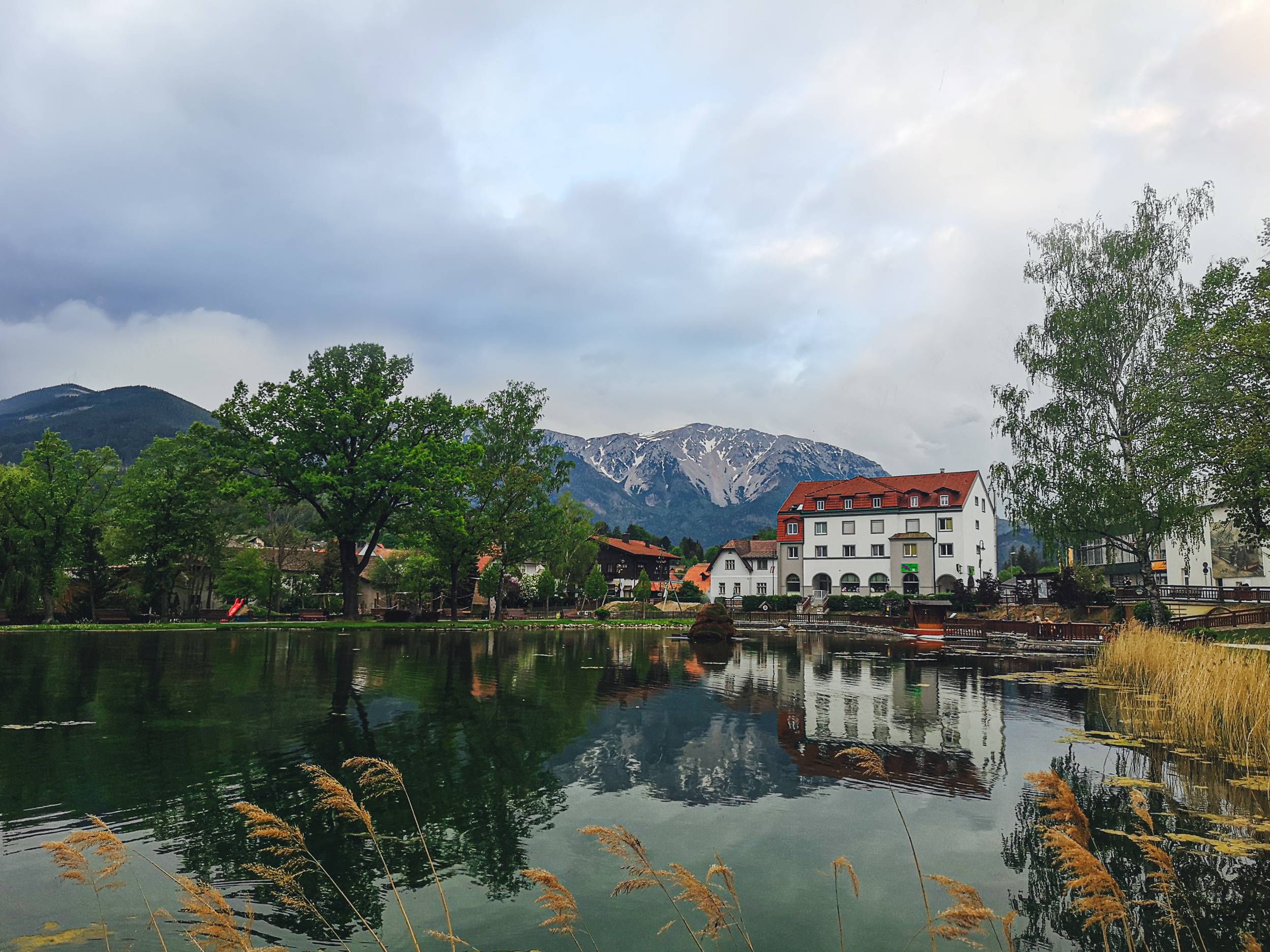
Puchberg am Schneeberg is the main hub to reach the highest mountain in Lower Austria. Photo by Alis Monte [CC BY-SA 4.0], via Connecting the Dots
The Schneeberg Railway is not the only structure connecting Vienna to the Alps. In 1873 a water pipeline was built between the rich karst plateau and the Capital of Austria, providing, what is claimed to be the best drinking water in the world.
Schneeberg Railway
Though the Schneeberg Railway is not as entitled as its cousin in Semmering, they are still members of one family. Both railways were built following the emergence of wanderlust for nature among the empire’s high class. The Alps particularly caught the interest of the public. With the advancement of engineering and humanity’s attempt to tame nature itself, it was only natural for such an empire as Austro-Hungarian to try and domesticate the closest true mountain to the Capital Vienna.
In 1895, the designs of Schneeberg Railway were laid down on a table and two years later the first locomotives were running the tracks. With 200 horsepower, these machines were immensely capable by those day standards. Though, the capacity, required for such a difficult track, came with a price. To deal with 1,218m / 3,996 ft vertical ascension and 9.7 km / 6 mi length route, the locomotives pulling 38 t cargo required 700 kg of coal and 4,500 l water. The latter had to be refilled at one of the three stationed water refilment stops.
Considering that Schneeberg Railway and all the required infrastructure was constructed more than a hundred years ago, it is quite an astonishing achievement. Today most of the cog train tracks are replaced by the modern counterparts, but Schneeberg Railway remains the longest such tracks in Austria. Though the railway is mostly used by new-age diesel-electric trains, the old locomotives are still running from time to time on a special occasion.

The easiest way to the top of Schneeberg is to use Schneebergbahn to Hochschneeberg and then climb the rest of 271 m / 889 ft yourself. Photo by Alis Monte [CC BY-SA 4.0], via Connecting the Dots
How to get to Puchberg am Schneeberg
One of the major advantages of Puchberg am Schneeberg is its connectivity. There are quite a few options to reach most of the areas in the valley. All thanks to the road B26, going from Weikersdorf to Neunkirchen, through this hidden paradise amid mountains. The two entrances create the dynamic of a relatively good connection to the region.
By train
As I mentioned before, it is almost possible to ride a train to the very top of the majestic Mount Schneeberg. Though first, you need to get to Puchberg am Schneeberg, which is just 1h39 minutes away from Vienna. If you are lucky, you can catch a direct train, but usually, the train has to be changed at Wiener Neustadt.
The Salamandra train from Puchberg am Schneeberg to Hochschneeberg train station is run by a private company, thus it is not covered by any ÖBB ticket.
Tip: If you are not traveling alone, I recommend buying Einfach-Raus Ticket for 35€.
By bus
While Salamander trains are convenient, they are quite expensive and as a matter of fact – not as fun for die-hard hikers. Once you get on the mountain, there are not that many places left to go.
The alternative is to take bus 1720 from Puchberg am Schneberg to Losenheim, where Schneeberg chairlift is located. It is much cheaper than the Schneeberg train and can lift you up to Edelweißhütte am Schneeberg at 1,235 m / 4,052 ft. You can either take the challenge to climb Schneeberg from there or walk on the ridge in this natural hikers’ paradise.
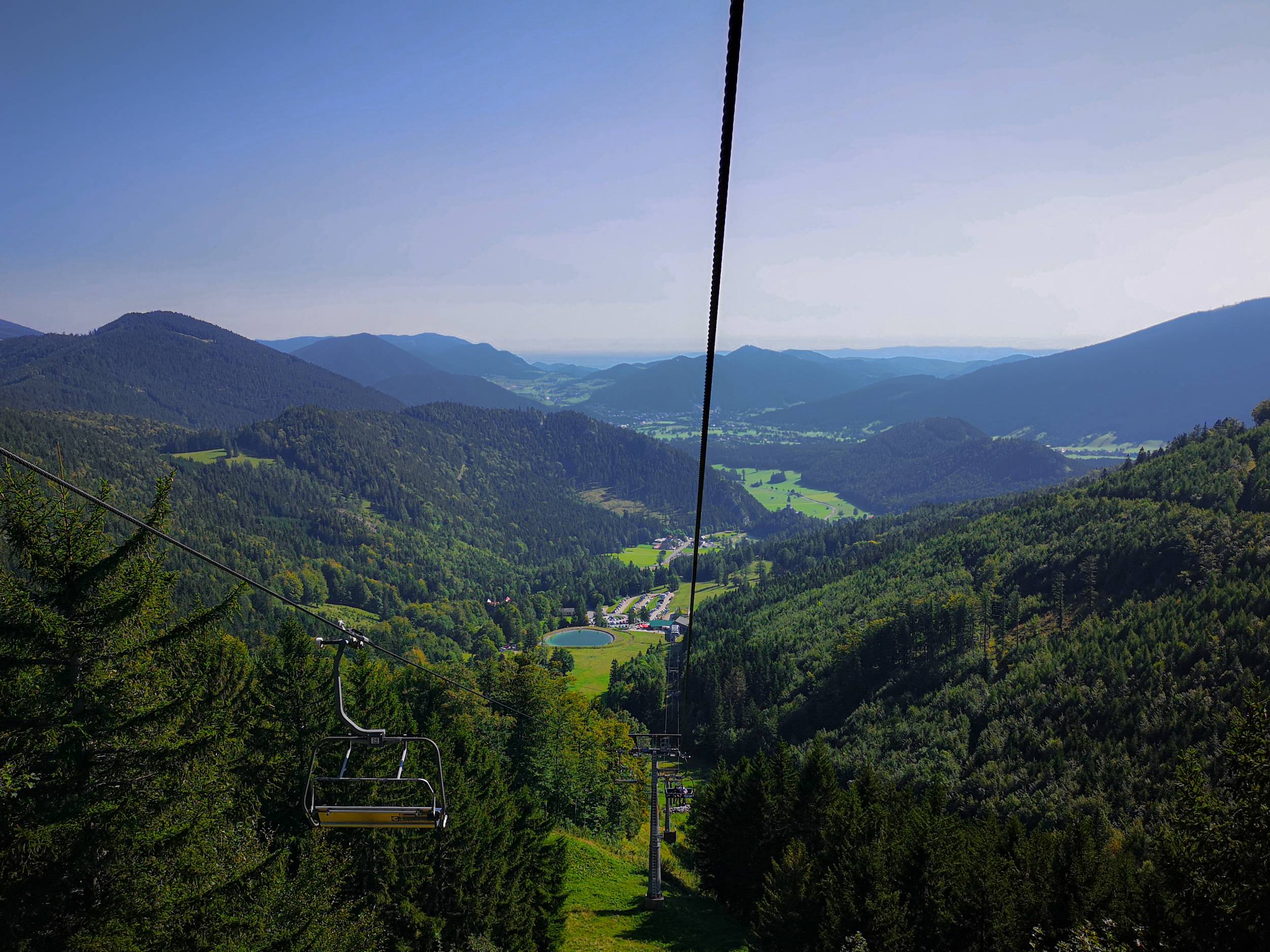
During the winter, the area around Schneeberg chairlift transforms into family-friendly skiing paradise. Photo by Alis Monte [CC BY-SA 4.0], via Connecting the Dots
Bus 1720 runs from Neunkirchen, thus another alternative to reach the foot of Schneeberg would be to take a train going through Neunkirchen and change there.
If you require the bus to get to your hiking spot, I would recommend using VOR Freizeit ticket for €19 / person. Both Regional trains and buses in Lower Austria and Burgenland are included in the price for a whole day.
Tip: As always, you can plan your trip best on ÖBB tickets website.
By car
Wherever the trains go, automobiles follow. From Vienna take A2 (South Autobahn) to reach Wiener Neustadt. Further on, you can either follow road B26, straight to Puchberg am Schneeberg, or continue on the South Autobahn and enter S6, from which in Neunkirchen you can enter the same B26 from the other end. The later route is usually longer, but it could be a viable option depending on the situation and destination.

The area around Schneeberg is just as impressive as the valley within. Photo by Alis Monte [CC BY-SA 4.0], via Connecting the Dots
Best Hikes Around Puchberg am Schneeberg
While there are more good hiking day trip destinations from Vienna to the Alps, have in mind that every route listed below, undoubtedly, is among the top routes. Schneeberg does roof the region, therefore it is the only place in Lower Austria, where you can see everything from above.1.
Edelweißhütte – Schneeberg
- Distance: ~7 km / 4.34 mi x2
- Ascend: 862 m / 2.828 ft
- Type: Linear
- Duration: 6h
- Difficulty: Hard
The best place to start your journey to the very top of Lower Austria is Edelweißhütte, which is a hut right next to the upper station of Losenheim chairlift. If you feel like doing it hardcore – be my guest to start it from the town, or even further, which is, I imagine, done by many locals. I’m not sure about the Viennese but Austrians are a true outdoor nation. I heard rumors that it is a common saying that every local has climbed Mount Schneeberg, and not just climbed but via Fadensteig.
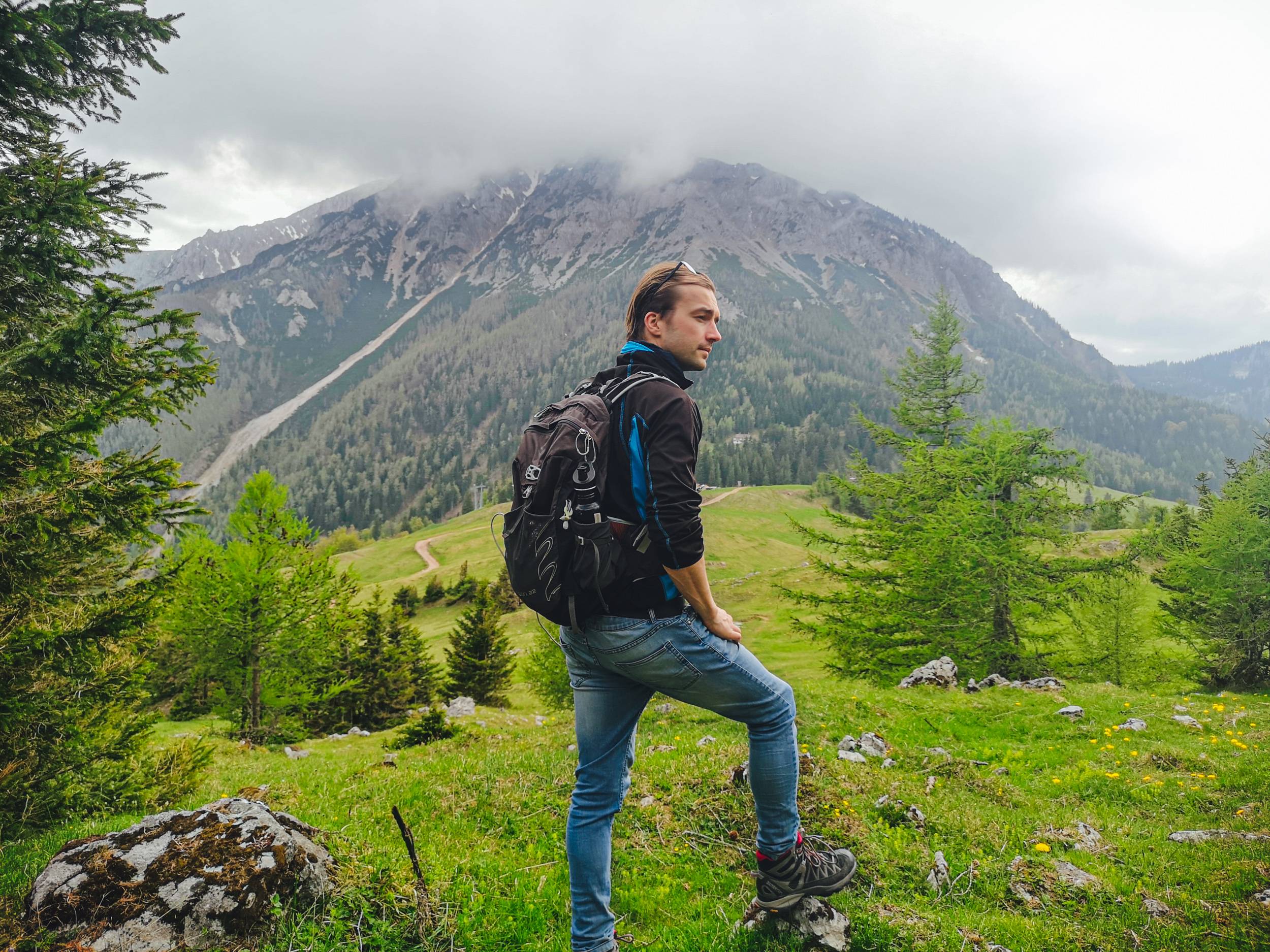
Dürre Wand is a mountain ridge extending straight from Schneeberg itself via Fadensteig. Photo by Alis Monte [CC BY-SA 4.0], via Connecting the Dots
I bet you can tell from the name that this route is not the easiest one. Fadensteig is the shortest way up to Schneeberg straight from Edelweißhütte. It goes up via the mountain ridge, which extends from Kaiserstein (the second highest peak of Schneeberg) to Dürre Wand. That reaches Puchberg am Schneeberg itself and even further to Gutenstein Alps. Many people chose to climb Schneeberg via Fadensteig and descend via Wurzengraben. For safety reasons I climbed the mountain using Wurzengraben and descended via a nearby road going through Schauerstein, 1,866 m / 6,122 ft.
It was not the technical reason, which scared me away but the popularity of Fadensteig. I was afraid that the rocky path was about to melt from the overuse and I don’t like taking chances.
Schneeberg
In the end, it doesn’t matter, which route you choose, getting on the top of Mount Schneeberg means being above all Lower Austria. That fact alone multiplies the regular joy of climbing the mountains. There is something very special about that feeling of being above everything else around. Maybe that emulates the heavens.
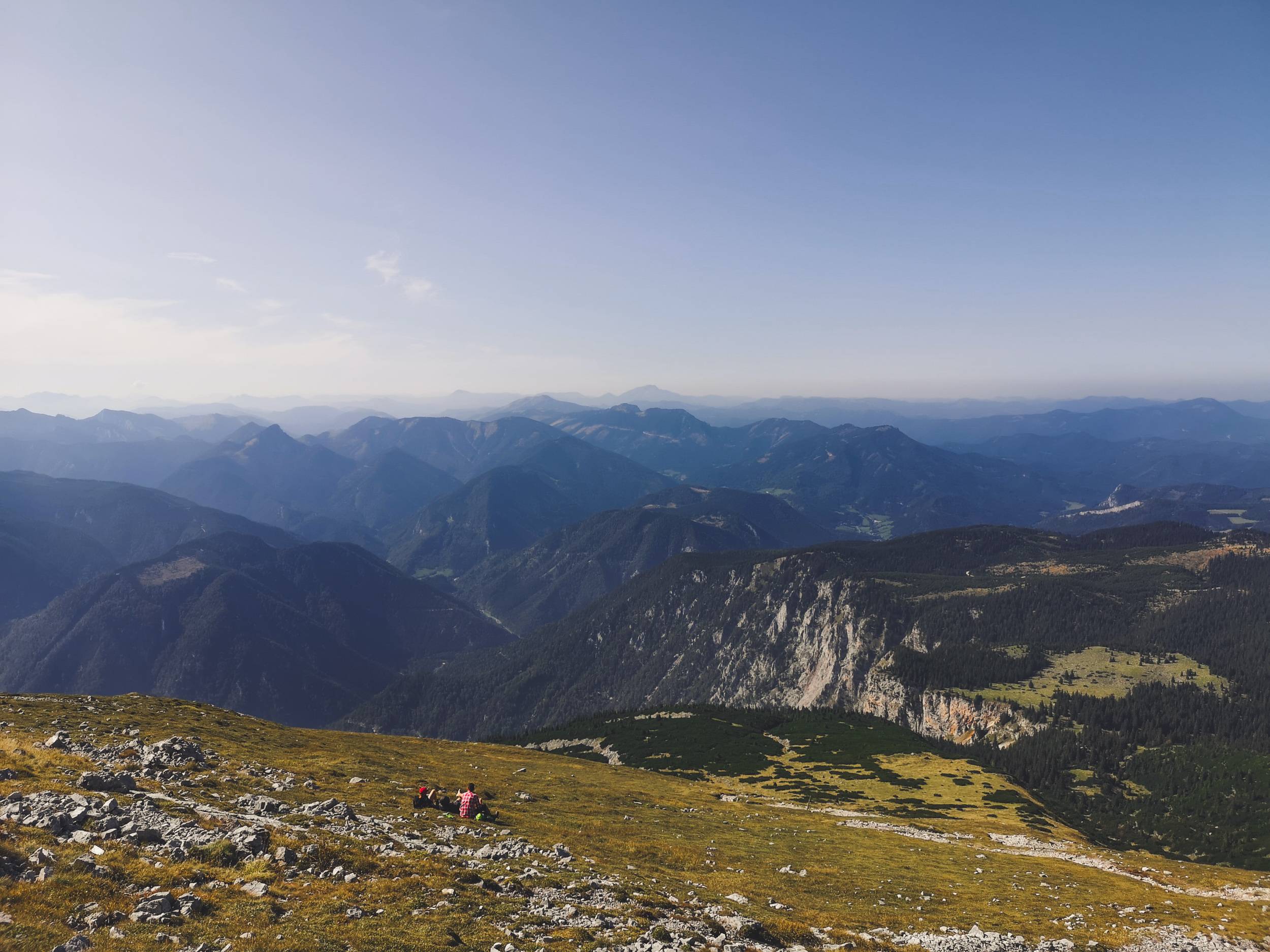
Beyond Schneeberg are the rest of the Alps we all know and love. Photo by Alis Monte [CC BY-SA 4.0], via Connecting the Dots
Schneeberg is definitely a special mountain. It wouldn’t surprise me if Schneeberg was not only the second most historically significant mountain in Austria but in the whole old Empire. Schneeberg is the easternmost mountain of the Alps ranging above 2,000 m / 6,562 ft, but it is not only the heights that make this mountain so intriguing. After all, it is located just in the hand’s reach of the Capital. Schneeberg is the local Vienna mountain.
Losenheim – Sebastianfalls
- Distance: ~7 km / 4.34 mi
- Ascend: 389 m / 1,276 ft
- Descend: 573 m / 1,880 ft
- Type: One direction
- Duration: 3h
- Difficulty: Intermediate
This route starts the same as if you’d decide to climb Mount Schneeberg without using the chairlift. In the same manner, as for the main hiking path in the area, the 375m / 1,230 ft climbing part between the lower and upper stations of the chairlift could be shortcutted. Doing so makes this hike from intermediate to easy, thus it is a viable option for anybody, who wants to experience the fairy-tale-like alpine forests without having to sweat too much.
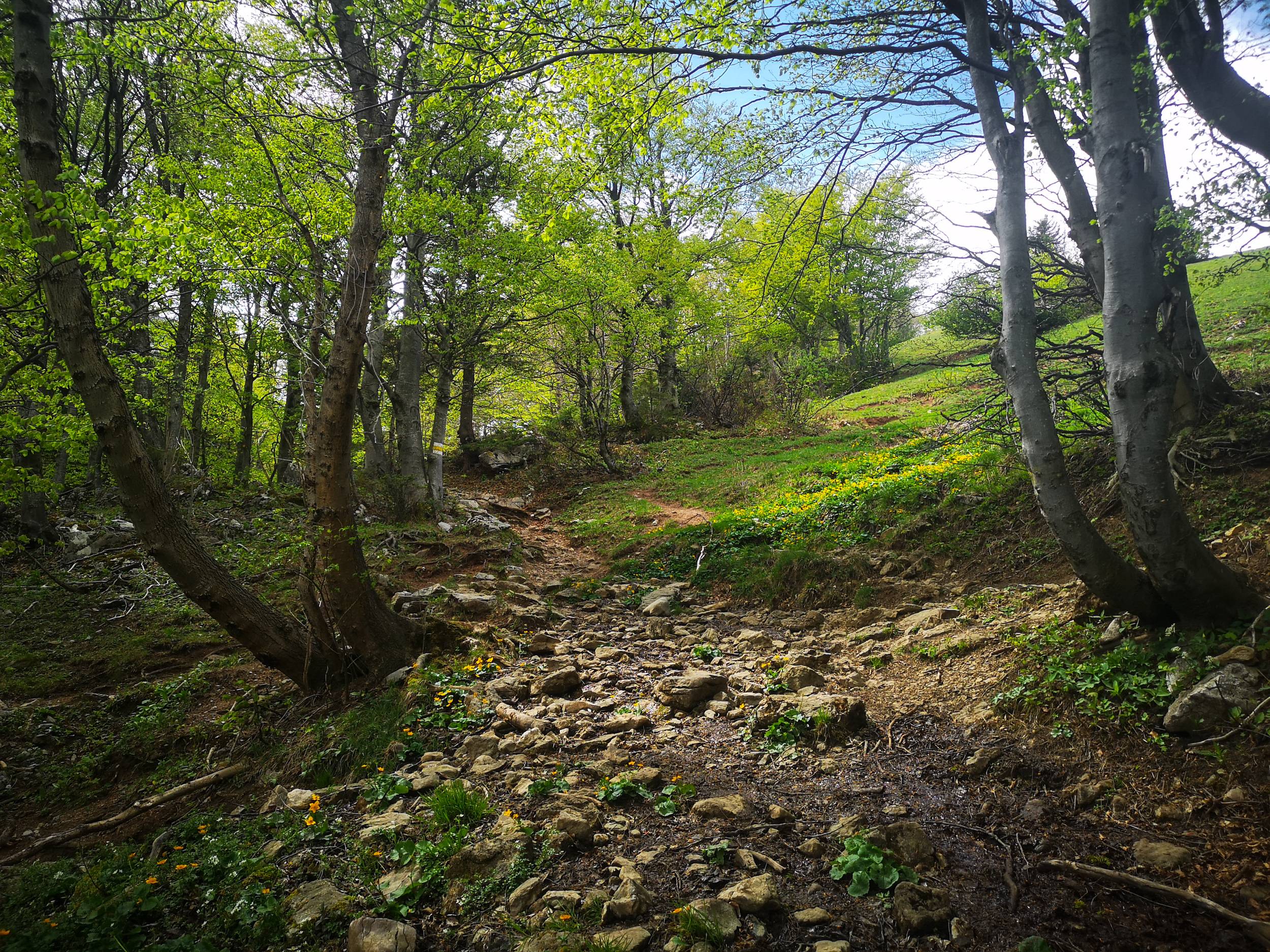
I couldn’t catch it on my camera, but we saw a unicorn around the corner here. Photo by Alis Monte [CC BY-SA 4.0], via Connecting the Dots
Though some parts of the climb might appear a bit mundane, I still insist that this is a road worth walking. The upper parts of this route have some of the most beautiful views of the valley and forests. The hike between Losenheim and Sonnleiten is a one-way path, therefore there won’t be a second chance to see the marvels it has to offer.Schneeberg chairlift is still a very fun experience on its own but one-way tickets are not as cost-effective. I would recommend combining it with other hikes, like climbing Mount Schneeberg.
From Edelweißhütte, the hiking road follows Dürre Wand mountain ridge with awe-inspiring views toward the valley, Gutenstein Alps on the other side, and the majestic Mount Schneeberg itself.
Sebastianfalls
The further path descends through a dense forest back to the valley. From place to place the road might be very steep and hard to walk but these are the perfect conditions for a waterfall like Sebastianfalls to emerge. The multiple cascades of falling water form a sight-not-miss of a total of 30 m / 98 ft in height.
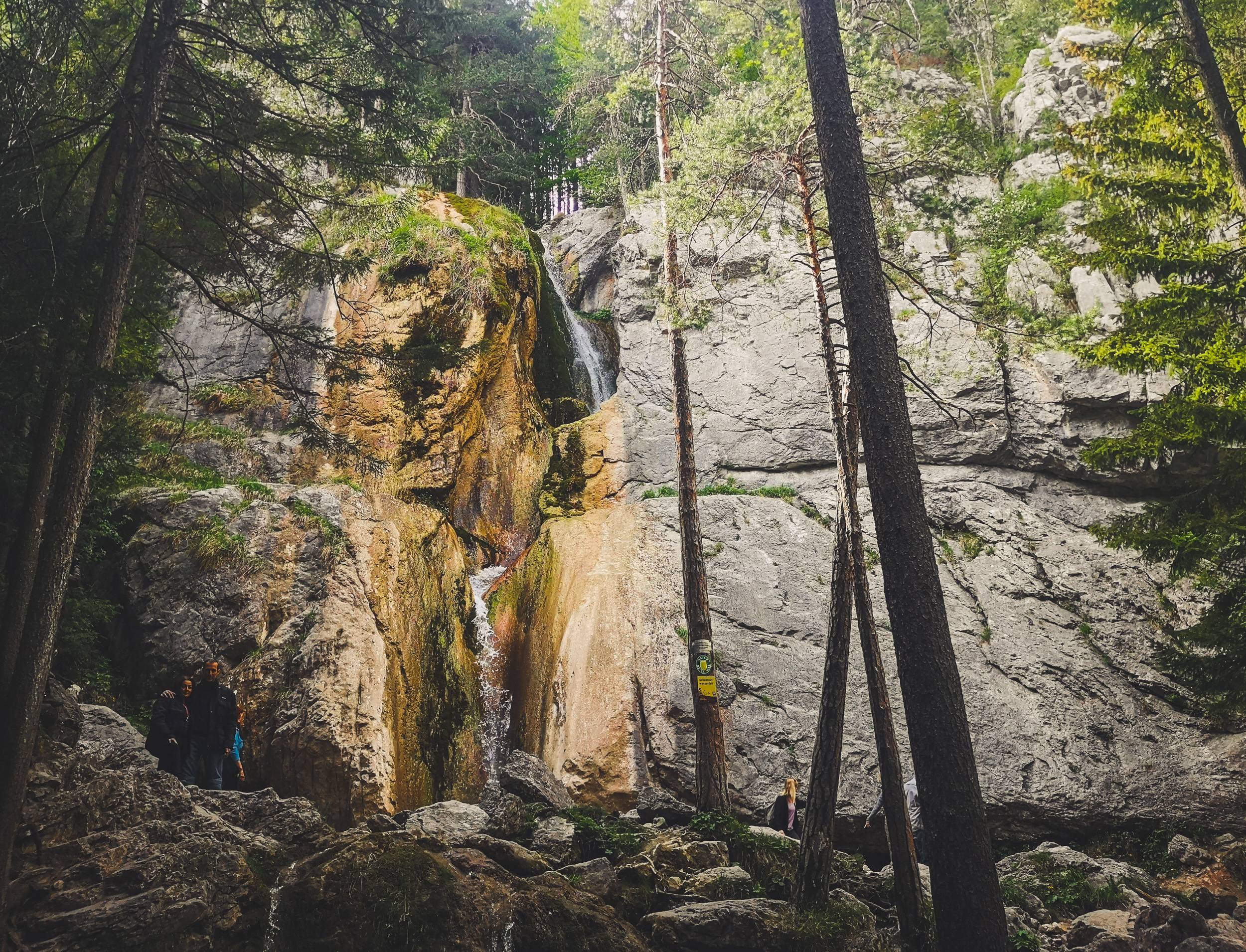
Sebastianfalls are easily accessed with a car, thus it is relatively crowded. Photo by Alis Monte [CC BY-SA 4.0], via Connecting the Dots
Though the waterfall is named after the great Johann Sebastian Bach, the reason for it remains uncertain. Many great composers spent their time in the worldwide capital of music but I found little to no evidence of J.S. Bach himself visiting the region, thus I assume Sebastianfalls got its name out of respect for this great genius of music.
Puchberg am Schneeberg – Himberg
- Distance: ~4.5 km / 2.8 mi
- Ascend: 352 m / 1,152 ft
- Type: Circular
- Difficulty: Intermediate
Himberg is a pyramid-shaped mountain (must be aliens), rising 948 m / 3,110 ft above sea level. Despite its relatively small size, I would have to say it is the second most interesting piece of landscape, visible from Puchberg am Schneeberg. Falling short behind Mount Schneeberg itself, which is kind of unfair, because you probably won’t going to find a single more interesting natural feature in the whole mountainous area of Lower Austria. So, second place is a pretty damn good result.
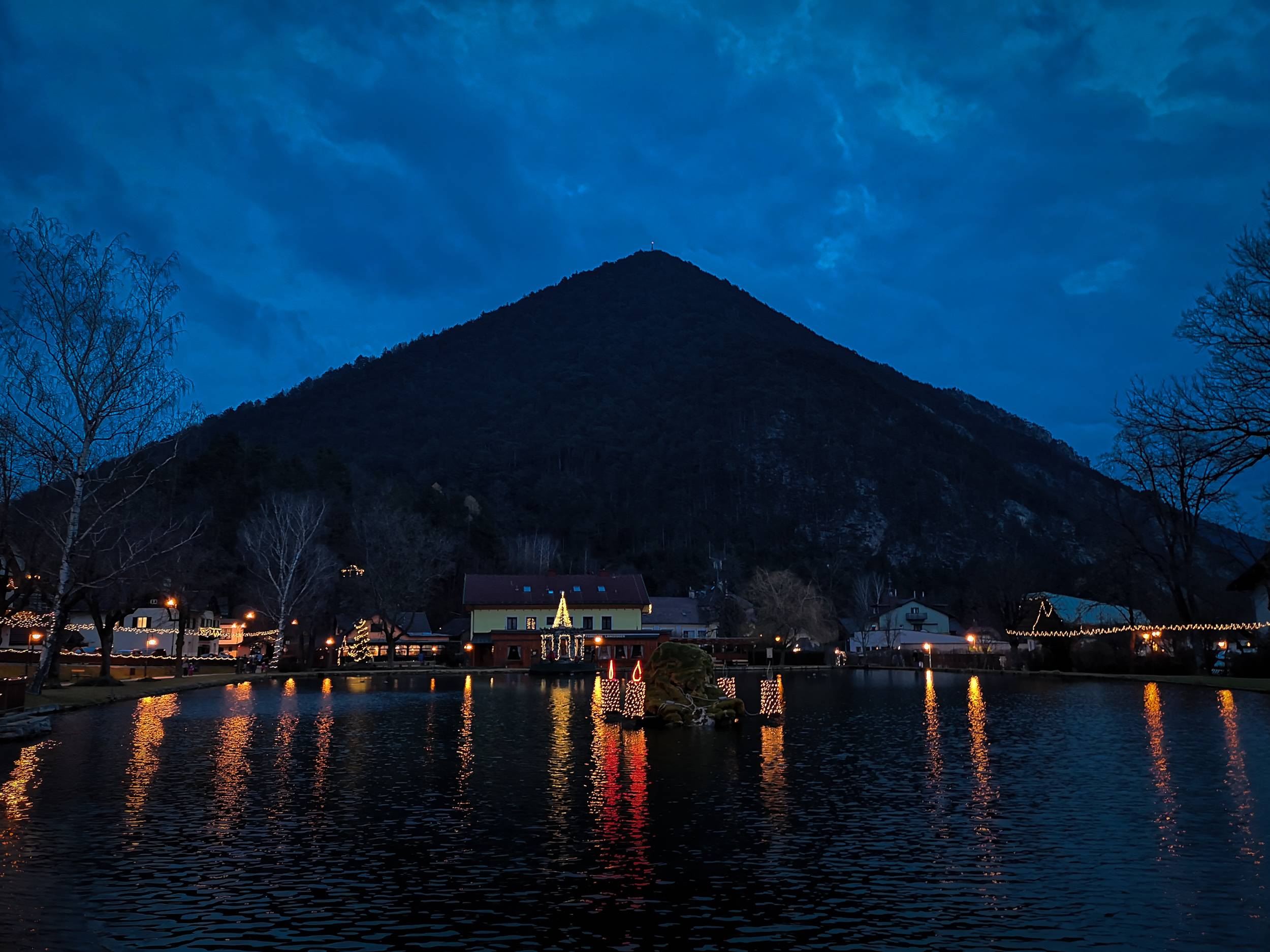
Himberg is the pyramid-shaped mountain right next to Puchberg am Schneeberg. Photo by Alis Monte [CC BY-SA 4.0], via Connecting the Dots
While Hiberg’s shape makes the mountain an interesting object to look at, it doesn’t necessarily mean it is fun to climb it. I have to admit that the even surface of the mountain, doesn’t make a most interesting hiking route. Unless you treat it like a true-labyrinth experience, the serpentine road (yellow mark), with a slowly changing angle of always the same view – might appear boring. In that case, you can try to climb the mountain via a slightly longer but a much more varied red-marked-hiking route.
Geierwand
I would still recommend using the yellow-marked road for descending. Not only because it has much better views but actual viewpoints over open rock wall – Geierwand. It might not look like much for hikers, except that it opens up a beautiful vista, but it is a perfect place for rock climbers.
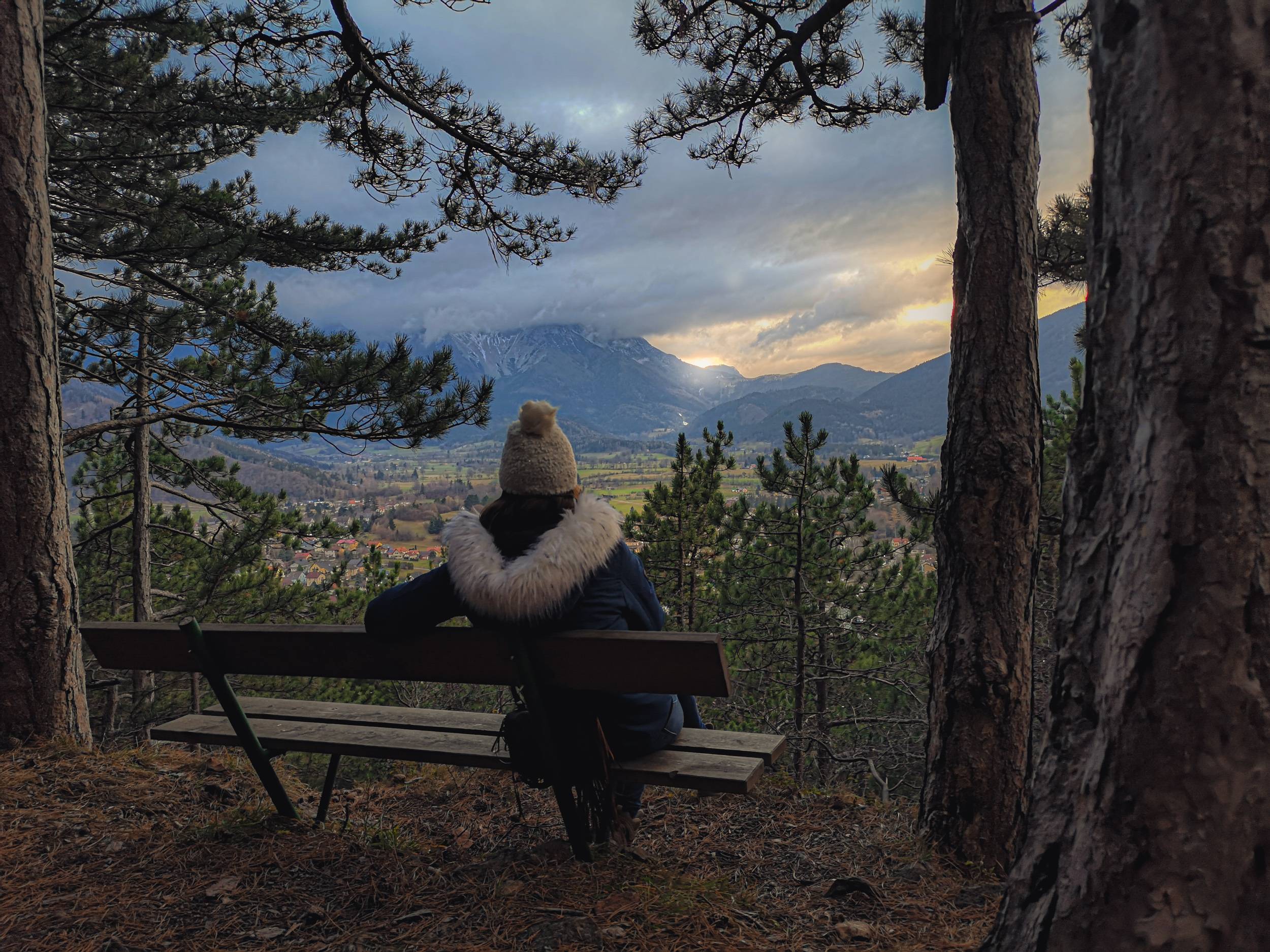
There are quite a few places like this on Himberg to take the moment. Photo by Alis Monte [CC BY-SA 4.0], via Connecting the Dots
Geierwand is only one of two viewpoints on the yellow-marked hiking route up to Himberg. The other one being Theresienfelsen, located a bit lower on the slope of the mountain. Visiting the viewpoints along the road will make the hike much more interesting.
Before considering this climbing Himberg, have in mind that it might be not the most exciting hiking route, it is not supposed to. This meditative hike is great if you have limited time or for recreational purposes – remember the therapy, right?
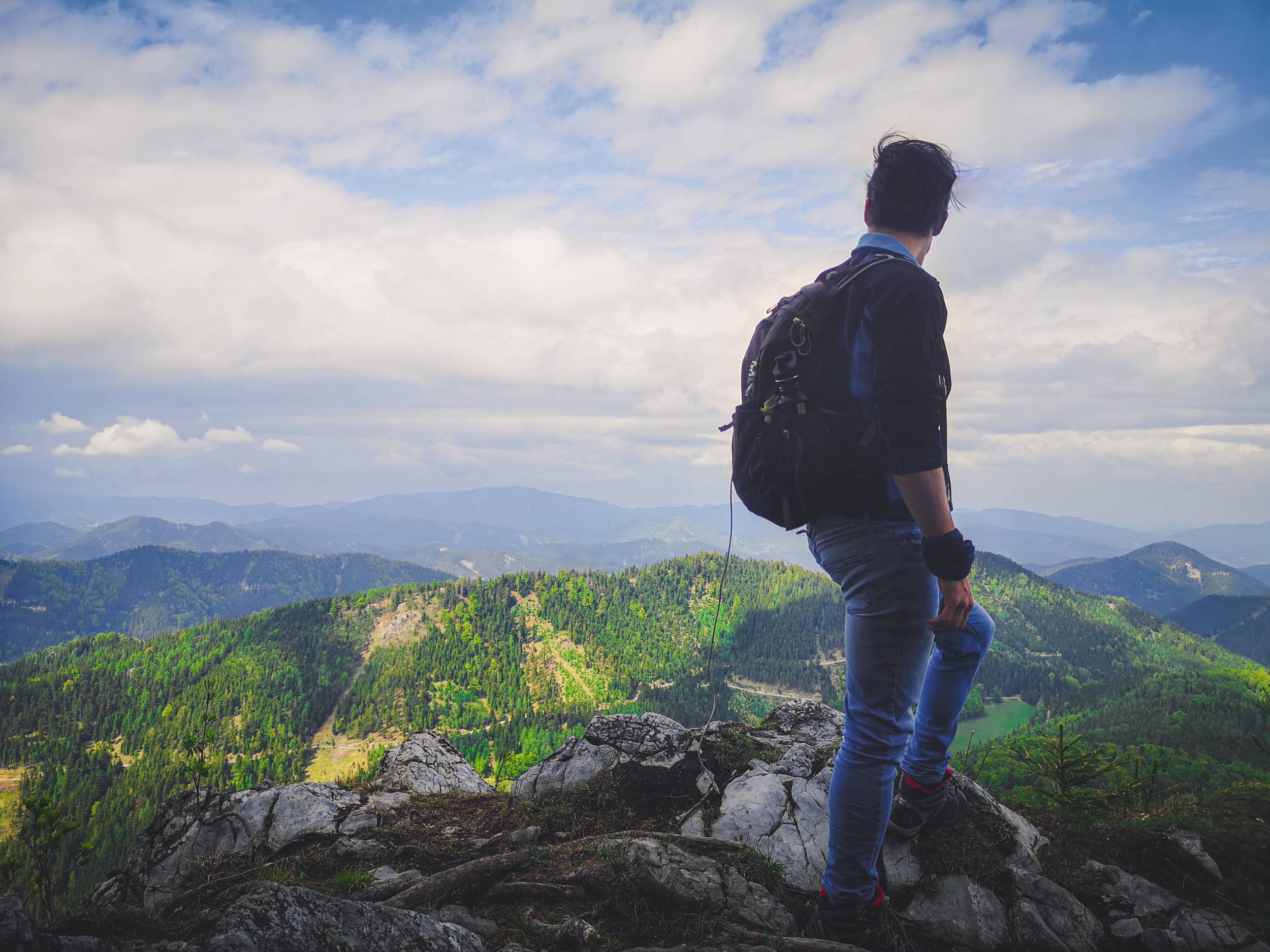
Mountains are one of the most captivating things to look at. Photo by A.L. [CC BY-SA 4.0], via Connecting the Dots
Personal Experience
I have mentioned this in a few articles already, but the area around Puchberg am Schneeberg is my favorite place to hike within a daily-reach from Vienna. The Valley below Schneeberg seems to be separated from the rest of the world. As everywhere else in the mountains, Puchberg am Schneeberg is a great place to clean your head from the daily routines, just more so. It doesn’t really matter where you go, the views toward the valley will be there and they are absolutely stunning.
If you never had visited the Alps near the Capital of Austria, for starters – I highly recommend a day trip from Vienna to hike around Semmering Railway. Despite that, I couldn’t recommend visiting Puchberg am Schneeberg more. Not that getting on the top of the whole Lower Austria is not a good reason enough to visit the area, you’ll find many pleasant hikes in the shadow of Schneeberg. Puchberg am Schneeberg might be a popular day trip destination among the locals but it is often overlooked by many tourists.
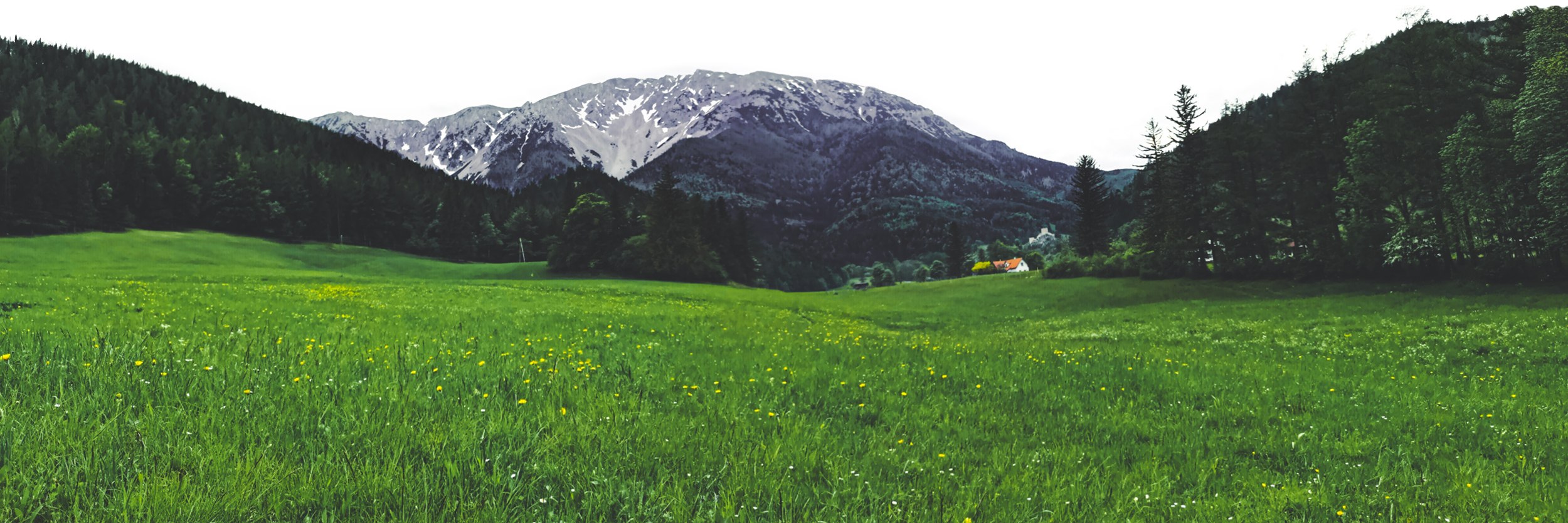
All content and photos by Alis Monte. If you want to collaborate, contact me on info@ctdots.eu Photo by Alis Monte [CC BY-SA 4.0], via Connecting the Dots